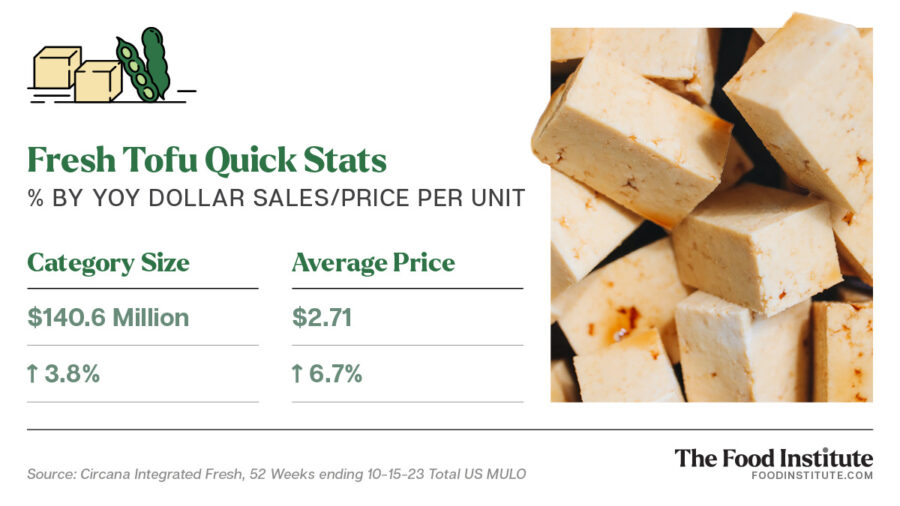Tofu is enjoying a new era of popularity thanks to its adaptability and nutritional clout. But despite its position as a plant-based powerhouse, this longtime vegan staple has its own share of hurdles to overcome.
Also known as bean curd, fresh tofu is prepared by coagulating soy milk and pressing the curds into solid blocks of varying softness: silken, soft, firm, extra firm.
“As a soyfood, tofu is one of the few plant-based proteins that’s a complete protein, meaning it contains all nine of the essential amino acids in adequate amounts,” U.S. soy nutrition expert Pam Smith, RDN, told The Food Institute. “It is also a time-tested conduit for flavor development – the subtle taste of tofu takes on and enhances the flavors of the ingredients it is prepared with – thereby its culinary playbook is extensive in all cuisines.”
Category Snapshot
Much like meat alternatives, the pandemic era boosted overall sales and adoption of tofu products. Per Nielsen data, tofu’s sales in the U.S. increased 40% in the first half of 2020, however, 2023 has presented growth challenges for most plant-based categories, as households tighten budgets and less devoted shoppers leave the category.
Per Circana, the fresh tofu category reached $140.6 million in the 52-week period ending October 15. Inflated prices are propping up tofu dollar gains while putting pressure on unit (-2.7%) and volume (-1.7%) sales. The cost of fresh tofu is currently 50% less than alt-meats, however, giving the ingredient a significant advantage among budget-conscious flexitarians.
Conquering Tofu Phobia
While the adaptability of tofu is significant, working with it can be intimidating for some consumers.
The biggest reason people don’t eat tofu is “tofu phobia,” observed David Knibbs, founder of The Tofoo Co., in a recent webinar hosted by The Grocer. “They’ve got this fear of the white block. They don’t know what to do with it.”
Cultural associations — from its ancient origins in Asian cuisine to U.S. counterculture veganism in the 1970s — can also be a constraint to broader adoption.
“[Tofu has] been around for 2000 years,” said Knibbs. “[For instance,] if people just see it as an oriental ingredient, then you’re narrowing the number of usage occasions.”
As Smith notes, though, tofu’s range of options and forms – smoked, marinated, crumbled – can help to demystify and simplify its preparation and make it convenient and appealing to a wider audience.
“Crumbles are an easy and tasty go-to for taco filling, breakfast scrambles, larb or salad or soup toppers; and dices can be air- or batter-fried,” said Smith. “Silken tofu can serve as a non-dairy ingredient, a base for mousses or pudding as well as a quality protein thickening agent in smoothies, sauces, soup, condiments, dips, and salad dressings.”
Outlook: Inspiration and Education
Social media platforms like TikTok are also helping to drive tofu adoption as recipe creators educate and engage the community.
“There seems to be no stopping the #TikTokMadeMeTryIt trend,” said Smith. “As users showcase innovative and easy-to-follow ways to prepare and enjoy tofu, tempeh, edamame, and soy milk to a viewer not familiar with these products, they are apt to try it and share it on their own feeds.”
Knibbs echoes this sentiment, adding that the strategy at The Tofoo Co continues to revolve around educating consumers and encouraging them to create great meals.
“There’s so much that you can do with tofu — one block, one thousand possibilities,” said Knibbs. “And people want to be inspired, don’t they? At the end of the day, I think that’s the reality of it.”











